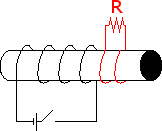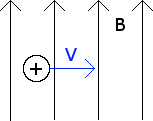Physics 2
A circuit has the following R = 20 , C = 25 F, = 10 V.
How long will it take for the charge to drop to one third its original value?
A region of the rectangular wire loop shown below sits in a uniform magnetic field directed into the page, = 7.0 T. The coil is being pulled to the right (shown in blue) at a velocity of 3 m/s. Note that the loop is being pulled into a region that does not contain a magnetic field. Find the:

C. Force required to pull the wire loop at constant velocity
A magnetic field increases with time as described by the function, B(t) = 4 + 6t. Given a coil with 880 turns, N = 880, and an area A = (.05m), find the induced voltage in the coil.
As a steel guitar string vibrates, the component of the magnetic field perpendicular to the area of a pickup coil nearby is given by B(t) = 50 mT + (3.20 mT) Sin (1046t). The circular pickup coil has 30 turns, a radius of 2.70 mm, and a resistance of 0.10 . What is the magnitude of the maximum current induced in the coil?
A square coil, with dimensions l = 12.0 cm, w = 7.0 cm, is placed d = 3.0 cm above a wire that carries a current of 30.0 A. Find the magnetic flux through the wire.

A rectangular wire loop rests in a magnetic field as shown. Points Y and Z are grasped and pulled tight so that the area of the loop becomes zero. Determine the direction of the current through the resistor.

A circular loop of wire is moving downwards towards a magnet as shown below. Find the direction of the induced current (viewed from above) as:

A. the loop approaches the north pole
B. the loop moves past the south pole
A conductive ring is falling through a magnetic field as shown below.

A. Sketch the direction of the induced current at each location
B. Where is the induced current the greatest?
Find the direction of the induced current in the resistors.
A.

The magnet is being pulled away in the direction of the arrow
B.

When the current, I, is increasing with time.
A metal rod is moved to the right through a magnetic field. A charge separation is induced as shown below. Determine the direction of the magnetic field.

A current carrying loop has a radius of 3 cm. The current is 7 A in the counter clockwise direction. Find the magnetic dipole moment,
The wire depicted below has a current I = 25.0 A, r = 9.0 cm and r = 6.0 cm. Find the magnetic dipole moment .

The circuit below is a square with sides L and is placed in a magnetic field directed into the screen. Attached to the circuit are two light bulbs of resistance R . The magnetic field is described by the function B(t) = at + b. What is the current in the circuit and in what direction does it flow. Also how much power is dissipated in light bulb 1.



